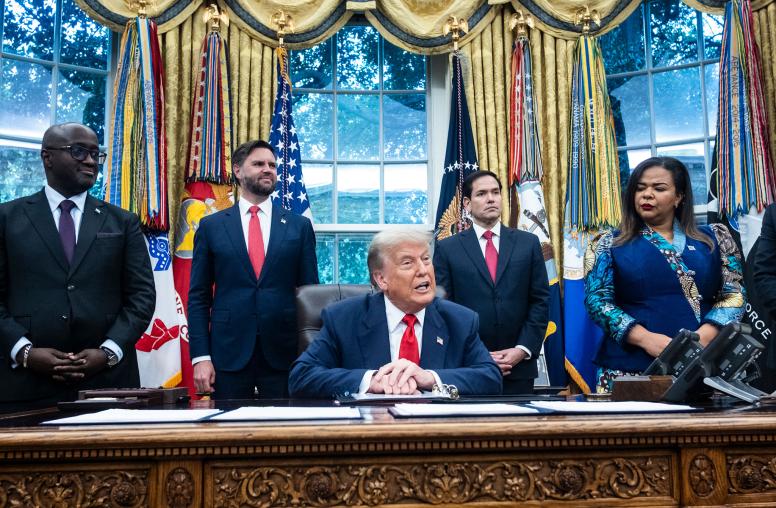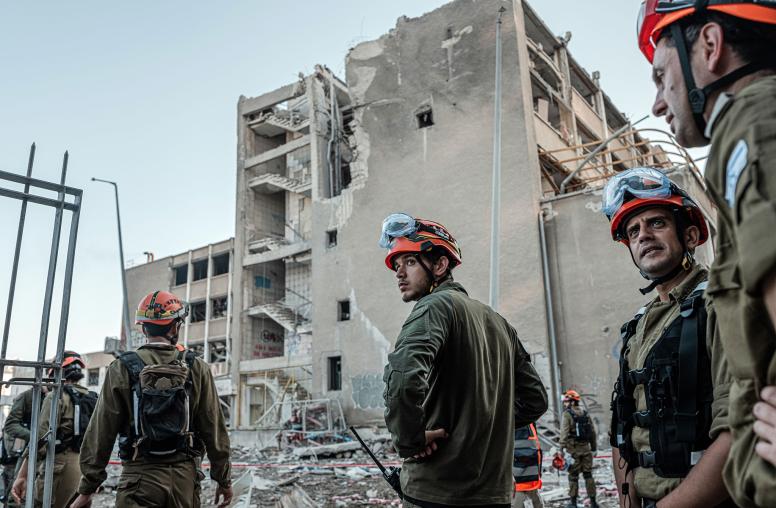USIP was directed by Congress in December 2004 to create a Task Force on the United Nations. The task force assessed the extent to which the United Nations is fulfilling the purposes stated in its Charter and recommended an actionable agenda for the United States on the UN. While not an official U.S. government effort, the Task Force was obligated to provide its report to Congress.
Task Force Members, Senior Advisors, and Partners
The members of the task force were a diverse and bipartisan group of distinguished Americans from a variety of professions and backgrounds. It was co-chaired by Newt Gingrich, former speaker of the House of Representatives, and George Mitchell, former majority leader of the Senate.
Other members included: Wesley K. Clark, Wesley K. Clark and Associates; Edwin Feulner, The Heritage Foundation; Roderick Hills, Hills and Stern; Donald McHenry, Georgetown University; Danielle Pletka, American Enterprise Institute; Thomas R. Pickering, The Boeing Company; Anne-Marie Slaughter, Princeton University; A. Michael Spence, Oak Hill Capital Partners; Malcolm Wallop, Asian Studies Center; and R. James Woolsey, Booz Allen Hamilton. The senior advisors to the task force were Charles Boyd, Business Executives for National Security, and J. Robinson West, PFC Energy.
As directed by Congress, the U.S. Institute of Peace organized the Task Force with the support and participation of leading public policy organizations, including the American Enterprise Institute, the Brookings Institution, the Center for Strategic and International Studies, the Council on Foreign Relations, the Heritage Foundation, and the Hoover Institution. These institutions provided experts to support the members of the Task Force.
Task Force Activities
The Task Force organized its work in five thematic areas. In addition to conducting research and taking testimony, members of the Task Force and experts undertook fact-finding missions to United Nations headquarters and to missions in the field. The five thematic areas were as follows:
- Preventing and ending conflicts and building stable societies.
- Preventing and responding to genocide and gross human rights violations.
- Preventing catastrophic terrorism and the proliferation of weapons of mass destruction.
- Ensuring the effectiveness, integrity, transparency, and accountability of the UN system.
- Fostering economic development and reducing poverty.
Background
To provide additional information on the background of the Task Force, relevant excerpts from the consolidated appropriations bill and accompanying report are included below. For additional information on the FY 2005 consolidated appropriations bill please visit the Library of Congress Legislative Information on the Internet System (THOMAS).
Language From the FY 2005 Consolidated Appropriations Bill:
United States Institute of Peace
OPERATING EXPENSES
For necessary expenses of the United States Institute of Peace as authorized in the United States Institute of Peace Act, $23,000,000: Provided, That $1,500,000 is for necessary expenses for the Task Force on the United Nations: Provided further, That the Task Force on the United Nations shall submit a report on its findings to the Committees on Appropriations of the House of Representatives and Senate not later than 180 days after the date of the enactment of this Act.
Language from the Nonbinding Report Accompanying the FY 2005 Consolidated Appropriations Bill:
. . . [T]he conferees direct the Institute to create a task force to study the United Nations efforts to meet the goals of its charter as signed in June of 1945. This study should address obstacles to achieving such goals, especially the goal of maintaining international peace and security and the promotion of universal respect for and observance of human rights and fundamental freedoms.
The conferees are deeply troubled by the inaction of the United Nations on many fronts, especially in regard to the genocide in Darfur, Sudan and the allegations of corruption regarding the United Nations Oil-For-Food program.
The task force should consist of experts from the following public policy forums: American Enterprise Institute, Brookings Institution, Council on Foreign Relations, Center for Strategic and International Studies, Hoover Institution, and Heritage Foundation.
The conferees anticipate the task force would not include more than 12 members. The conferees expect the results of the study to be presented to the Committees on Appropriations within 180 days of the enactment of this Act.




